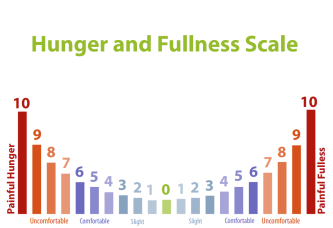By Megrette Fletcher
What would happen if your child had a superpower? Okay, maybe this superpower won’t mean he’ll jump buildings in a single bound, but if your child always knew when to stop eating, would you count that as a superpower? Let’s imagine your child looks at you with a bright face and a confident voice that says, “Excuse me, mom, I have had enough. May I be excused?”
Would that be a benefit at meal times?
 If you to believe that stopping eating when you are comfortably full will help your health, and the health of your family then tuning into fullness is a terrific place to start. I have some even better news! Every child is born with this superpower. It is just waiting for you, the teacher, to awaken his/her ability into the spotlight.
If you to believe that stopping eating when you are comfortably full will help your health, and the health of your family then tuning into fullness is a terrific place to start. I have some even better news! Every child is born with this superpower. It is just waiting for you, the teacher, to awaken his/her ability into the spotlight.
Coaxing this ability to sense fullness is possible by having checking in with fullness, part of your meal time. If you are a baseball fan, think of checking in with fullness as a mealtime equivalent to a 7th inning stretch. This is a pause that becomes part of your families mealtime culture.
Getting more specific, look at the rating scale pictured. It is divided into three sections. Numbers 10-7 is when either hunger or fullness is painful and unpleasant, 6-4 is when hunger or fullness is comfortable, and 3-1 is when hunger or fullness is slightly noticeable.
Between hunger and fullness is the number zero, and this is the most important number to notice when finding fullness. Zero is the point when you or your child are neither hungry nor full. It is also the moment in eating where you can help your child shift his/her intent from satisfying hunger to finding fullness.
Coach your child when eating to notice this place where he/she is no longer hungry but still has not become comfortably full. The ability to recognize this moment will help him/she become more aware of the many choices that are available when eating. For a younger child, your coaching might sound like, “Lets pause and check in with your fullness. Do you want to keep eating, or is your tummy comfortable?” Creating this open dialogue between you and your children, strengthens the bonds between parent and child, and teaches you both how to learn and trust each other. For an older child, you can expand the conversation to other decisions might be made, including after meals snacking or having desserts.
 The ability to recognize the absence of hunger is enhanced by slowing down at mealtime, reducing eating distractions such as TV and other electronic devices, and intentionally noticing and rating your child’s current physical sensations like fullness. If your mealtimes are already relaxed and include checking in, shift your focus to observing this neutral point in the meal. When engaging your child in conversations during the meal, direct part of your mealtime talk to include hunger, fullness and how these are changing to help your child remember that it is normal for him/her to observe fullness.
The ability to recognize the absence of hunger is enhanced by slowing down at mealtime, reducing eating distractions such as TV and other electronic devices, and intentionally noticing and rating your child’s current physical sensations like fullness. If your mealtimes are already relaxed and include checking in, shift your focus to observing this neutral point in the meal. When engaging your child in conversations during the meal, direct part of your mealtime talk to include hunger, fullness and how these are changing to help your child remember that it is normal for him/her to observe fullness.
Once your child has satisfied the acute hunger, the flavor of food changes. Sure the food may still taste good; however, the amount of enjoyment your child receive from each bite is less and less until finally eating is no longer pleasurable. Children (and adults) often pick at the remaining food on the plate. Recognizing that the pleasure of eating will decrease with each bite, provides, even more reason not to force a child children to eat when not hungry. This tendency to push food not only will overfill the child, but it can make a pleasant meal, unpleasant. Remember, eating past a comfortable level of fullness and eating food that is no longer enjoyable becomes painful, both physically and emotionally.
 The ability to find a comfortable level of fullness is a skill that you and your child were born with. If this superpower was forgotten to you, don’t worry, you can reclaim it as you begin to coach your child on becoming aware of fullness. In doing so, a new sense of energy and health is created by not overeating.
The ability to find a comfortable level of fullness is a skill that you and your child were born with. If this superpower was forgotten to you, don’t worry, you can reclaim it as you begin to coach your child on becoming aware of fullness. In doing so, a new sense of energy and health is created by not overeating.
I hoped this post was helpful. You don’t ever have to miss an issue of Mindful Eating for Kids! Just sign up here!
